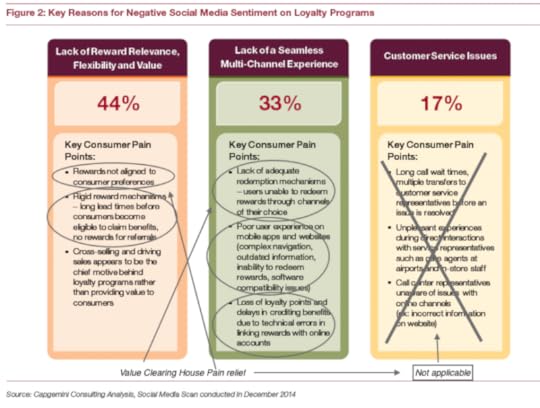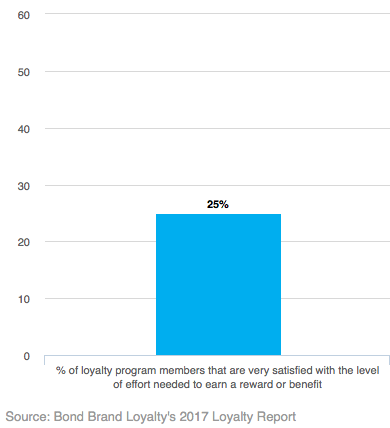VCH can solve most loyalty program dissatisfaction issues – incentive for corporate participation
“In the U.S., [companies] spend $50 billion annually on loyalty programs; they’re just not hitting the mark,” Capgemini study author Mark Taylor.
2017 Bond Brand Loyalty study (with Visa) shows consumers are evaluating their loyalty program experience on elements far beyond the dividend and rewards. Members who find their loyalty program to be enjoyable are 10 times more likely to be satisfied, yet only 31% feel this way.
According to Capgemini Consulting (via CNBC)
“[T]he average U.S. household belongs to more than 21 loyalty programs.
Shoppers actively use fewer than 50 percent of the rewards programs to which they belong.
On social media nearly 90 percent of the conversation around loyalty programs is negative.
Complexity and effort annoy 75%
“Point theft”
Companies go out of their way to convince loyalty program participants that the points received from expenditures are valuable. They use words like “earned” to give that a psychological boost. That works against the company when it expires points or changes the program to devalue points. Participants feel robbed and cheated. (How airline loyalty programs seduce and abandon you)
Old Technology
Capgemini’s study: although 79 percent of loyalty programs use mobile strategies to target shoppers, less than a quarter allow them to redeem rewards through the technology. This makes it difficult for consumers to easily bounce between the web and the store while shopping, and can cause retailers to miss out on a potential sale.
Lack of choice
Limited selection of rewards to cash in points for

Source: Capgemini: Fixing the Cracks: Reinventing Loyalty Programs for the Digital Age (pdf)
Lack of value
Lack of perceived value in point “purchases.” — In addition to the difficulty often experienced in obtaining rewards for points, and lack of choice of merchandise that can be had for points consumers often feel that the merchandise being offered is over-priced — that the consumer is not getting value for their value points.
Physical merchandise is difficult to price for a purchase using points because there is a fixed cost of the merchandise as well as the shipping costs. This is especially annoying because consumers consider free shipping a modern-day birthright: The most important factor in online shopping.

What satisfies loyalty members? How does VCH fit in?
Further reading
6 Things I Hate About Loyalty Programs – FICO, Consultant Tim Young (Tim Young is a principal consultant at FICO. Tim has over 15 years’ experience spanning banking, finance, retail and marketing analytics. )
Best Loyalty & Rewards Programs: Top Marketing Experts
Index of all documents
Value Clearing House – Summary
First goal: save American journalism
Why is news a good first entry into digital content loyalty payments?
Why would companies who offer loyalty programs like VCH?
Case history: Starbucks
VCH can solve most loyalty program dissatisfaction issues – incentive for corporate participation
How does VCH work?
Solution: Monopoly money for Monopoly digital content — The San Quentin wrapper solution
Proprietary and confidential information of Lewis Perdue. Not to be disclosed to or shared with third parties without written permission.





